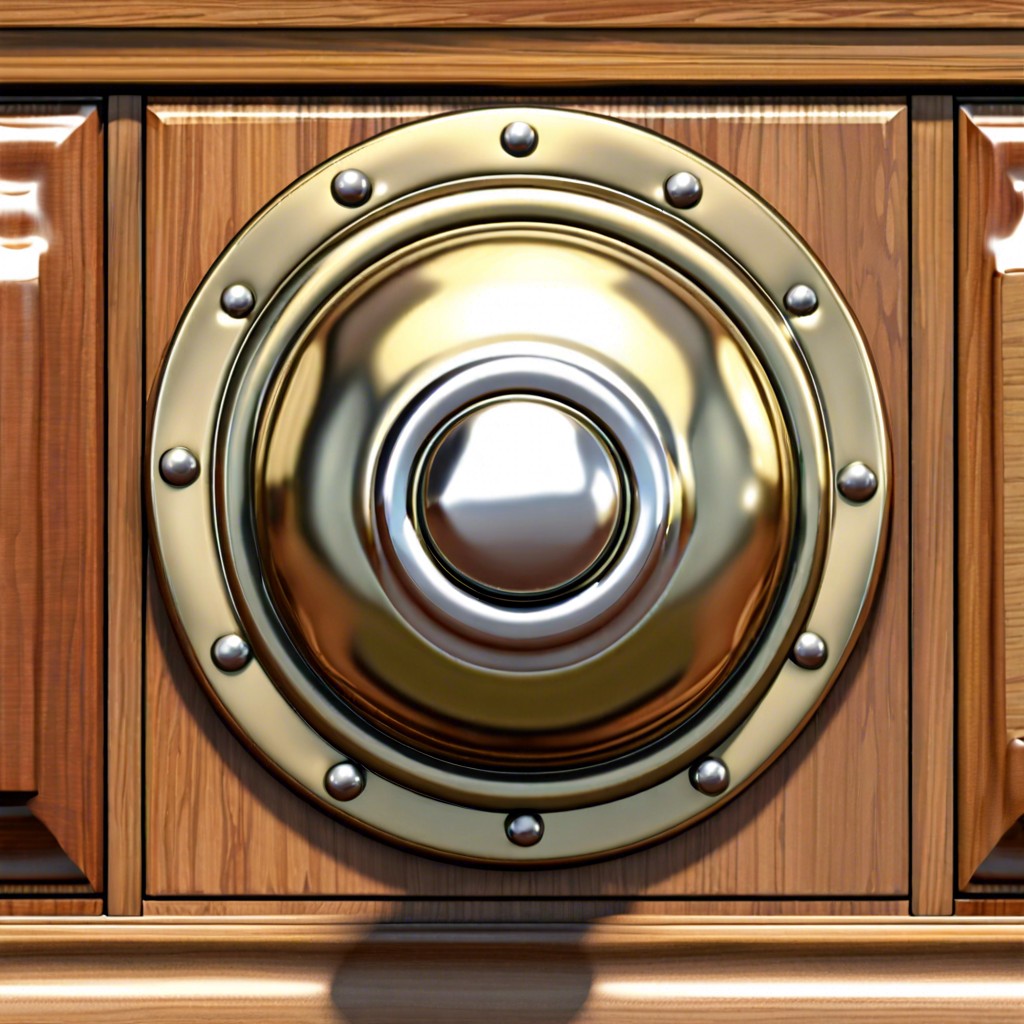Last updated on
Learn where to place cabinet pulls for optimal function and aesthetics in your kitchen.
Are your cabinets sporting the placement equivalent of a bad haircut, and you’re not sure how to fix it? Worry no more! Dive into this detailed guide to master knobs vs. pulls, perfecting placement on upper and lower cabinets, drawers, and even mixing them up like a pro. Say goodbye to second-guessing and hello to a kitchen makeover that’s as functional as it is stylish. Let’s get pulling!
Key takeaways:
- Knobs add classic look, pulls fit modern styles too.
- Consistent placement boosts functionality and aesthetics.
- Pulls on upper cabinets like earrings, make them impactful.
- Symmetry and easy reach key for lower cabinets.
- Center knobs on drawers for balance, easy use.
What's Inside
Knobs Vs. Pulls

Knobs and pulls both serve useful purposes, but choosing between them can impact both the function and aesthetic of your cabinets.
Knobs are generally easier to install—just a single screw, and voila! They add a classic, timeless look to your kitchen. Perfect for traditional and farmhouse styles.
Pulls, on the other hand, have the advantage of offering a firm grip, making it easier to open heavy drawers or larger cabinet doors. More modern and versatile, they come in a variety of sizes and finishes to fit any style.
Remember, knobs are often best for smaller doors and drawers, while pulls suit larger surfaces. And hey, mixing them up can create a visually interesting space.
Pull Placement On Upper Cabinets
Think of upper cabinet pulls as the earrings of your kitchen decor—small yet impactful.
Place pulls horizontally on both upper and lower sections of cabinet doors. For extra flair, position them about two to three inches from the corner of the door. This not only adds style but is ergonomic for easy opening.
Vertically oriented doors? Mount the pulls centered vertically but near the edge of the opposite hinge for balance and function. It’s all about keeping things comfortable and stylish.
Shorter cabinets may benefit from pulls centered higher to draw the eye up. Taller cabinets may need mid-height placement for equally easy reach.
Remember, consistency is key—whether you’re cooking up a storm or just Instagramming your latest kitchen masterpiece.
Pull Placement On Lower Cabinets
For lower cabinets, the placement of pulls can make or break your kitchen’s functionality and aesthetics. Here’s what you need to know:
First, always aim for symmetry. Place pulls horizontally on lower cabinets to create a balanced look. Center them horizontally on the door frame.
Positioning away from hinges helps avoid awkward wrist positions. Mount the pull about 2 to 3 inches from the top corner opposite the hinge. This ensures easy access and smooth operation.
Consistency is key. Align all pulls across your lower cabinets at the same height, giving a cohesive and professional appearance.
For wide drawers, consider two pulls for even distribution, keeping each pull near the thirds of the drawer width. This prevents uneven wear and tear.
Remember, you’re not just installing hardware; you’re setting the stage for your daily kitchen adventures. Make it easy and stylish, and your future self will thank you every time you reach for that spatula.
Pull Placement On Drawers
First things first: the center is king. Typically, pulls are placed horizontally in the center of the drawer front. This makes it easy to grab from any angle.
For larger drawers, one pull might not cut it. Use two pulls evenly spaced to make opening a breeze and keep things balanced. Bonus points if your cabinets don’t look like they’re auditioning for a crooked art show.
If you’re dealing with deep drawers for pots and pans, center the pull vertically and horizontally for the easiest access.
Think kid-friendly. Lower drawers are often accessed by the little chefs in your life. Ensure the pulls are at a reachable height.
Test it out. Before committing, use painter’s tape to mock up the positioning. Open and close the drawer a few times to see how it feels.
Knob Placement On Upper Cabinets
For upper cabinets, the sweet spot for knobs is usually 2.5 to 3 inches from the bottom corner. Why? That’s typically where your hand naturally falls when reaching up. Think of it as meeting your knobs halfway; they shouldn’t require a stretch workout!
Knobs work like charm there because they are easy to grip. Imagine boiling pasta, one hand juggling a pot, the other cleanly grabbing that knob.
Centering knobs vertically works well too, especially on taller upper cabinets. It visually divides the space nicely – sort of like a happy, balanced yoga pose for your kitchen.
When dealing with extra tall cabinets, place the knob about 3 inches down from the top. This ensures consistency and keeps your design looking sharp.
Knob Placement On Lower Cabinets
When it comes to knob placement on lower cabinets, think easy reach and visual appeal. Place knobs on the opposite side of the hinges, typically about 2.5 to 3 inches from the corner of the door or drawer. This makes them easy to grab and adds symmetry.
Aiming for consistency? Match the height of knobs across all lower cabinets. For doors, align knobs vertically on the center edge of the stile. For drawers less than 24 inches wide, the center is ideal. For wider drawers, two knobs evenly spaced look great and are practical.
Consider functionality. Knobs should be comfortable to hold and not too high or low for different heights in your household. Keep them user-friendly by placing them where even the littlest kitchen helpers can reach.
Also, always double-check with a measuring tape before drilling. Crooked knobs are the kitchen equivalent of mismatched socks—not the end of the world, but why invite the chaos? Securely attaching knobs ensures a long-lasting hold and avoids the wobbly horror show of a loose knob.
Knob Placement On Cabinet Drawers
When it comes to drawers, the ideal placement for knobs is centered on the drawer front. This keeps things looking balanced and makes it simple to pull the drawer open. For larger drawers, especially those wider than 24 inches, you might consider using two knobs. One on each side can provide better stability and easier access.
Knob placement is also dependent on drawer height. On taller drawers, placing knobs towards the upper section prevents any awkward bending or wrist twists. You get better leverage this way.
Regardless of the knob style you choose, consistency in placement across all drawers is key for an aesthetically pleasing look. Let’s avoid a game of hide and seek with your knobs, shall we?
So, center those knobs on small drawers and consider dual knobs for the wider ones. It’s all about making your kitchen both beautiful and functional. Plus, you’ll feel like a design pro.
Cabinet Pull Placement Tips
Select pulls that complement the cabinet style. For a sleek modern look, go for horizontal pulls on both upper and lower cabinets. It creates a streamlined appearance.
Keep pulls centered horizontally on drawers for a balanced look. It’s easier on the eyes and your hands will naturally find the center.
For tall cabinets, place pulls vertically in the bottom third of the door. You’ll thank yourself every time you don’t have to stretch like you’re auditioning for the circus.
To ensure uniformity, use a measuring tape and a template. Otherwise, you risk a wonky look that’ll drive your inner perfectionist bananas.
Mixing sizes? Use longer pulls for wide drawers to balance out the visual weight. Trust us, nobody likes a stubby pull on a giant drawer.
When in doubt, test it out. Tape the pulls in place before drilling. If it looks funky, reposition until it looks just right. It’s like accessorizing your kitchen – no one walks out wearing mismatched shoes, right?
Remember, functionality is key. Put pulls where your hand naturally falls. No gymnastics required every time you grab a snack.
Mixing Knobs and Pulls
Combining knobs and pulls can add visual interest to your cabinets. It’s like balancing a seesaw but for your kitchen.
Knobs typically work best on doors, since they’re easy to grip and open. On upper cabinets, place them on the lower corners of the doors. For lower cabinets, position them on the upper corners. This keeps a consistent look and feel.
Pulls are your go-to for drawers. They provide better leverage, making it easy to open even the heaviest ones. Install them horizontally in the center of each drawer for a clean, balanced appearance.
You can also use pulls on larger cabinet doors, especially pantry-style ones. These can be placed vertically along the opening edge for easy access.
Mixing knobs and pulls offers both aesthetic and practical benefits. Plus, it gives you an excuse to spend an extra thirty minutes contemplating hardware styles in the store—every kitchen enthusiast’s secret guilty pleasure.




